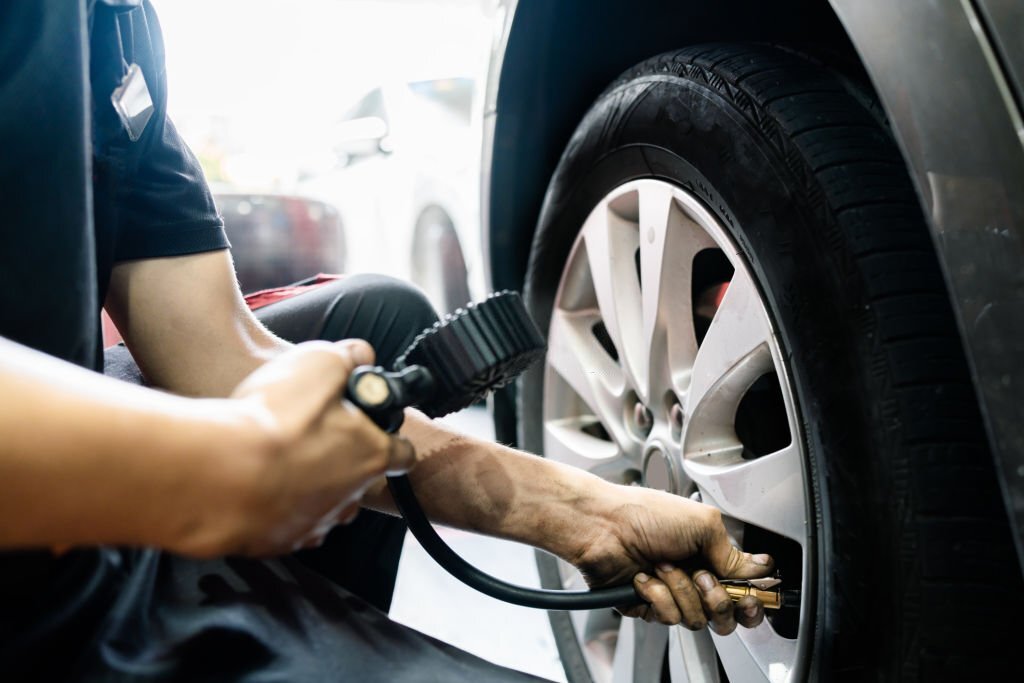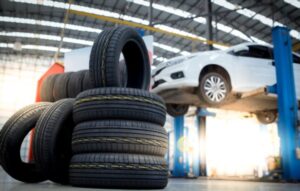Your tire pressure should be set according to the recommended pressure listed in your vehicle’s owner’s manual or on the tire information placard located on the driver’s side door jamb or inside the glove compartment. The recommended tire pressure is based on the manufacturer’s specifications for your vehicle and tire size.
Driving with the correct tire pressure is important for several reasons. Properly inflated tires provide better fuel efficiency, handling, and overall performance. They also help to extend the life of your tires, as underinflated tires can wear out faster and overinflated tires can wear unevenly.
It’s important to check your tire pressure regularly, at least once a month, using a tire pressure gauge. You should also check your tire pressure before long trips and when the weather changes significantly, as temperature changes can affect tire pressure. If your tire pressure is low, add air until it reaches the recommended pressure. If it’s too high, release some air until it reaches the recommended level. Remember to check your spare tire as well.
How to find maximum tire pressure on the sidewall of your tires?
The maximum tire pressure can be found on the sidewall of your tires. Here are the steps to find it:
- Locate the sidewall of your tire. This is the outermost part of the tire that makes contact with the road.
- Look for a series of numbers and letters on the sidewall. The maximum tire pressure is typically listed along with other information, such as the tire size and load capacity.
- The maximum tire pressure is usually listed in pounds per square inch (PSI). It may be listed as “MAX PSI,” “MAXIMUM PRESSURE,” or “MAX LOAD PRESSURE.” The number listed is the maximum recommended pressure for that tire.
- Keep in mind that the maximum tire pressure listed on the sidewall is not necessarily the recommended tire pressure for your vehicle. You should always refer to your vehicle’s owner’s manual or the tire information placard for the recommended tire pressure.
- It’s important to note that exceeding the maximum tire pressure listed on the sidewall can be dangerous and may cause the tire to fail. Always follow the recommended tire pressure for your vehicle to ensure safe and optimal performance.
What happens if you go over the maximum tire pressure?
Exceeding the maximum tire pressure listed on the sidewall of your tires can be dangerous and can cause several issues:
- Reduced traction: Overinflated tires have less surface area in contact with the road, reducing traction and making it more difficult to stop or control the vehicle.
- Uneven tire wear: Overinflated tires may wear unevenly, with the center of the tire wearing out more quickly than the edges.
- Decreased ride comfort: Overinflated tires can make the ride feel rougher, as they transmit more vibrations and shocks from the road surface to the vehicle.
- Risk of tire blowout: Overinflated tires are more likely to fail, especially when exposed to heat or other stresses, which can cause the tire to blow out or fail catastrophically.
In general, it’s important to always follow the recommended tire pressure for your vehicle, which can be found in your vehicle’s owner’s manual or on the tire information placard. If you’re not sure what the recommended tire pressure is, you can check with a tire professional or contact the tire manufacturer for guidance.
How do you check your tire pressure?
To check your tire pressure, follow these steps:
- Obtain a tire pressure gauge. You can purchase a tire pressure gauge at an auto parts store or online.
- Check your vehicle’s owner’s manual or the tire information placard (located on the driver’s side door jamb or inside the glove compartment) for the recommended tire pressure.
- Remove the valve cap from the tire.
- Press the tire pressure gauge onto the valve stem until you hear a hissing sound. This indicates that air is flowing into the gauge.
- Remove the gauge from the valve stem and read the pressure displayed on the gauge. Compare the reading to the recommended tire pressure.
- If the tire pressure is too low, add air until it reaches the recommended pressure. If the pressure is too high, release some air until it reaches the recommended level.
- Repeat the process for all four tires, as well as the spare tire.
- Replace the valve caps on each tire.
It’s recommended to check your tire pressure at least once a month and before long trips. Keep in mind that temperature changes can also affect tire pressure, so it’s a good idea to check your tire pressure when the weather changes significantly. A properly inflated tire can improve fuel efficiency, handling, and overall performance, as well as extend the life of your tires.
How to reset the tire pressure light?
The process for resetting the tire pressure light can vary depending on the make and model of your vehicle. Here are some general steps to follow:
- Check your vehicle’s owner’s manual for specific instructions on resetting the tire pressure light.
- Inflate your tires to the recommended pressure levels. The recommended pressure can be found on the tire information placard, located on the driver’s side door jamb or inside the glove compartment.
- Turn the ignition to the “On” position, but do not start the engine.
- Locate the tire pressure monitoring system (TPMS) reset button. This may be located under the steering wheel or in the glove box.
- Press and hold the TPMS reset button until the tire pressure light blinks two or three times.
- Release the button and wait for the tire pressure light to turn off. This may take a few minutes.
- Start the engine and verify that the tire pressure light has turned off.
Note that some vehicles may require a special tool or scan tool to reset the tire pressure light. If you’re not sure how to reset the tire pressure light on your vehicle, consult your owner’s manual or contact a professional mechanic.
What tire pressure is too low?
If the tire pressure is too low, it can cause several issues such as reduced fuel efficiency, poor handling, uneven tire wear, and increased risk of tire damage or failure. The exact tire pressure that is considered too low will depend on the recommended tire pressure for your vehicle.
To find the recommended tire pressure, check your vehicle’s owner’s manual or the tire information placard, which is typically located on the driver’s side door jamb or inside the glove compartment. The recommended tire pressure is usually expressed in pounds per square inch (PSI).
As a general rule, if the tire pressure is more than 25% below the recommended level, it is considered too low. For example, if the recommended tire pressure is 32 PSI, a pressure reading of 24 PSI or lower would be considered too low.
It’s important to check your tire pressure regularly and maintain it at the recommended levels to ensure optimal performance, handling, and safety. If you’re not sure what the recommended tire pressure is for your vehicle, consult your owner’s manual or contact a professional mechanic.
What are signs that your tires might be underinflated?
Here are some signs that your tires might be underinflated:
- Reduced fuel efficiency: When your tires are underinflated, your vehicle has to work harder to move, which can lead to decreased fuel efficiency.
- Poor handling: Underinflated tires can cause your vehicle to feel unstable or sluggish, making it more difficult to steer or maneuver.
- Uneven tire wear: When your tires are underinflated, the edges of the tire tend to wear out faster than the center, which can cause uneven tire wear and reduce the lifespan of your tires.
- Bulges or cracks: If your tires are severely underinflated, they can develop bulges or cracks on the sidewalls.
- Tire pressure warning light: Many modern vehicles are equipped with a tire pressure monitoring system (TPMS) that will alert you if your tire pressure is too low. If your TPMS light comes on, it’s a sign that you should check your tire pressure.
- Visual inspection: You can also visually inspect your tires for signs of underinflation, such as a flattened or squished appearance or if the tires appear to be sagging at the bottom.
It’s important to check your tire pressure regularly and maintain it at the recommended levels to ensure optimal performance, handling, and safety. If you suspect that your tires are underinflated, check the pressure and inflate them to the recommended level as soon as possible.


